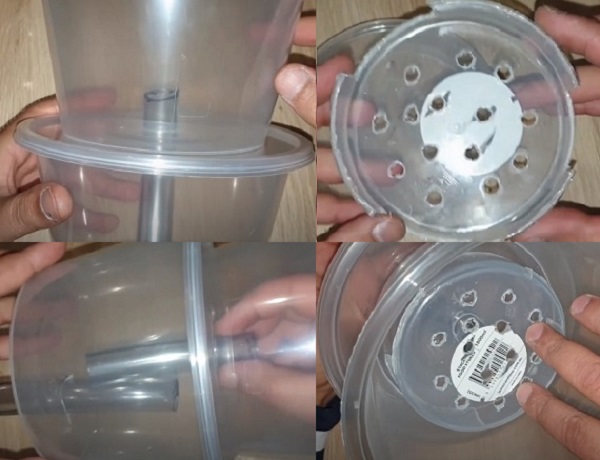How to Build a DIY Trickle Filter | Top Aquarium Sump Filter:
In an ordinary trickle filter,
water from the fish tank is taken out via an overflow. But in my homemade DIY
trickle filter, I have pumped water out of the fish tank with the help of a
submersible pump & water is allowed to flow back to the aquarium using
gravity. Unclean water is taken out from the fish tank that flows through
mechanical filtration media, then it flows through bio media & clean water
is allowed to flow back to the aquarium using gravity. This trickle filter
works very similar to an aquarium top SUMP filter because in overhead SUMP
filter, powerhead is used for pumping water outside the aquarium & then
water flows through mechanical & bio media, & back to the aquarium
using gravity.
It is very simple to make a DIY
trickle filter using household stuff. Ordinary tools are enough for building a
homemade trickle filter. Low energy is needed for operating trickle filters. Water
falls from the top to the bottom container on its own & then clean water
flows back to the aquarium. Trickle filter runs simply & you can simply
maintain this filter. Moving & trickling water offers an excellent gas
exchange area that can be used to aerate water. There is no need to use an air
pump for generation of oxygen.
In below video I have shown you how to make a trickle filter for fish tank:
Steps: How to make a trickle filter:
Trickly filters are easy to make
at home using household stuff. It needs food containers, a powerhead, an
internal hose, inlet & outlet hoses, & a few more components.
Step 1: Choose containers & hoses:
This DIY trickle filter is made
of home tools. 2 food containers are used for making this filter. If you have a
large tank then choose large containers because they will hold more filtration
media & will clean water efficiently. You can use a garden hose as an
internal hose for attaching both containers. Use a hose that fits the outlet of
your powerhead as an inlet hose. Also, you can use a garden hose for your
filter outlet too.
Step 2: Setting up trickle filter components:
Cut a hose in 2 small pieces.
Place the lid on the container & make a hole for the internal hose. Insert the internal hose in the hole, invert the lid & place it on top of another container.
Drill a hole for the outlet hose in the bottom container. It will let water flow freely to the aquarium using gravity. Use an outlet hose that should be inserted in the bottom container & its length will determine how much water your filter holds.
Separate the base of a broken container. It will be used as a tray for holding mechanical filter media. Drill holes in the tray so that water can flow through it.
Make a hole in the side of the top container & insert an inlet hose. This will allow the powerhead to pump water to the filter.
It is time to assemble filter
components. Use silicone to seal connections. I am using Selley's silicone but
you can also use any other aquarium safe silicone. Selley's silicone takes 7
days in full bonding.
I have attached both top &
bottom containers using a hose. The top container holds foams that can offer
mechanical filtration while the bottom container holds bio media used for biological
filtration. Fish waste, remaining food & other debris are trapped in the
top container while water free of solid particles flow through the bio media.
It is very important to note that fish waste release ammonia & bio media
holding nitrifying bacteria breaks down ammonia into nitrites & further
into nitrates. Nitrates are less poisonous than nitrites, & nitrites are
less poisonous than ammonia. So, water containing only nitrates will flow back
to the aquarium. If you choose the bio media that grows denitrifying bacteria
then it consumes nitrates. It is very important to choose the bio media that
holds both nitrifying & denitrifying bacteria such as ceramic noodles.
Nitrifying bacteria grows in abundance on large surfaces containing oxygen
while denitrifying bacteria will grow in oxygen free places. Ceramic rings have
many tiny little pores that allow denitrifying bacteria to grow inside because
these pores are air free. If your bio media can’t consume nitrates then either
use aquarium plants that absorb nitrates as fertilizers or weekly partial water
changes are required. If your bio media consumes nitrates then still you can’t
skip partial water changes because fresh water contains minerals that live
plants & fish need. It is advisable to perform a 30 to 35 percent water
change in a week & do not change more water at a time because you will also
lose lots of beneficial bacteria that grows everywhere in the aquarium. Ensure
that water must flow through the biological media & not just over the media
because if water does not interact with the beneficial bacteria, then useful
bacteria will not be able to break down ammonia byproducts. You can simply
achieve this by adjusting the hose length. Use the video for choosing the right
length of the hose.
Step 3: How to setup filter media in a trickle filter:
Place foam on top of the filter
tray. Top compartment is for mechanical filtration. Fill ceramic rings in the
bottom container till it reaches the tip of the outlet hose. Water capacity of
the container depends on the length of the outlet hose.
I am using this DIY top SUMP filter for a small aquarium so I have selected only fine foam as mechanical filter media & have used a bag of ceramic noodles as bio media. For a bigger aquarium filter I think you should use coarse, medium & fine foams that need lower filter maintenance & offer higher efficiency. Coarse foam will trap large solid particles & smaller particles will pass through the coarse foam but will be trapped by medium foam & very tiny particles will even flow through the medium foam but will be collected by fine foam. If fine foam can trap all particles, then why do we use coarse & medium foams. The answer to this question is very simple, larger particles will clog up the fine foam very quickly which will reduce its efficiency so use coarse & medium foams too so that fine foam can work efficiently for longer periods of time without needing maintenance. It is up to you which biological media do you want to select but I would suggest you to select bio media that hold both nitrifying & denitrifying bacteria because abundance of nitrates could be very toxic & for some fish if the level of nitrates is slightly higher then it could be fatal for example, discus fish are very sensitive to nitrates level so they need very frequent water changes if your aquarium filter media does not hold denitrifying bacteria.
Step 4: Testing DIY trickle filter:
It is time to test the trickle
filter. Insert the inlet hose in the top container. Water will enter the filter
through the inlet hose then it will flow through the foam & clean water
will enter the second container containing the ceramic rings. Water will be
pushed to the bottom of the second container using a hose & then it will
rise upward through the ceramic rings till it reaches the tip of the outlet
hose that will let water flow back to the aquarium using gravity.
Benefits of a DIY trickle filter:
Trickle filters have lots of
benefits & they are able to address more future problems that’s why I made
a DIY trickle filter for my aquarium. You can simply customize the filter
chambers & increase the number of chambers for holding more filtration
media. Based on your future needs you can add third or fourth chambers for
holding more filtration media especially if you want to use the same filter for
a larger aquarium. Just like canister filters you can easily customize the
filter media based on your tank requirements & maintenance of trickle
filters is easy because your filter media is neatly located in every chamber so
it will be easy to wash the filter media & easily put them back in their
original containers.
Also, it is possible to convert
your trickle filter into an aquaponic filter by putting some live plants inside
the filter for example pothos plants. Another name of the pothos plant is money
plant. Plants will absorb ammonia byproducts & other impurities from the
water that will help plants to grow well.
Other uses of trickle filters include cleaning of fish waste, dead leaves, & wiping out impurities released from decaying matter such as dead plants or fish. Filters are used to balance the ecosystem in an aquarium & provide a natural environment for the fish because naturally in moving streams water is clean, it is oxygenated & fish are thriving in clean water with abundance of minerals. Partial water changes are also required for adding minerals in the water.





Post a Comment